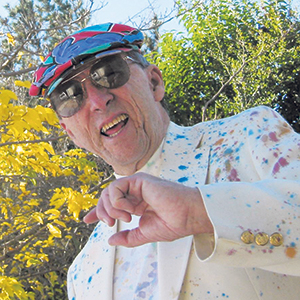Features & Columns
Ray Ashley Dedicated Life to Supporting South Bay Artists
 Ray Ashley was always good for an eccentric outfit and an art purchase or two.
Ray Ashley was always good for an eccentric outfit and an art purchase or two.The San Jose arts community has lost one of its most legendary benefactors. As a collector, Ray Ashley probably owned more pieces of art than anyone in San Jose history. A disabled Vietnam veteran, Ashley was a fixture at gallery auctions for decades.
He'd show up at venues like MACLA, the San Jose Institute of Contemporary Art, or WORKS, decked out in groovy paint-splattered attire, only to outbid much higher-rolling people.
Everyone either knew him or at least saw him at a gallery somewhere. Ashley believed in supporting local artists and he gave everyone a chance.
"He was extremely democratic in his collection of art," said Joe Miller, head honcho at WORKS. "He was definitely picky about what he would go for, as a collector. That was maybe his biggest influence on local arts, in that he owned something -- often more than one piece -- from just about all of us."
Over the years, Ashley filled his entire three-bedroom house in West San Jose with a few thousand pieces. Close friends said the inside of his home was literally covered—two or three layers deep in some places—with artworks collected throughout his adult life. Sometimes it was difficult to even walk through Ashley's home, just from all the art sitting around. His collection, some of which was already shifting to the Triton Museum's permanent holdings, could be understood as a literal catalog of South Bay art over the last several decades.
"Floor to ceiling, every room, had art on it," Miller recalled. "The bedrooms he wasn't using were stacked with art coming out from the walls, paintings stacked 10, 15, 20 deep that you could flip through. Some of them would still be wrapped from being at auctions."
Since Ashley's home was a veritable museum, 10 years ago, when WORKS was located on Third Street, the gallery staged a riotous exhibit of his collection. Titled, Ray's World: An Overwhelming Look at Ray Ashley's Passion for Art, the exhibit recreated the inside of Ashley's house inside the WORKS gallery, complete with a bed and a few American flags, along with dozens of pieces on the wall. Visitors received a crazy glimpse into the life of a truly eccentric, one-of-a-kind collector with a fantastic eye for what he wanted.
Now that Ashley has left us, the Triton Museum will be taking the most of what's left of his collection. Years ago History San Jose was able to catalog some of the collection, but much still remains undocumented.
Above all else, Ashley was one of those characters who helped define an arts community. At WORKS, his financial contribution to the gallery via his myriad purchases over several decades was second only to the city of San Jose in terms of the gallery's overall monetary support. He was an authentic patron of the arts, he threw eclectic barbecues and he thrived on giving back.
"One of the cool things about Ray was his penchant for collecting not just fine art, but knick-knacks that he just loved," said Al Preciado, a local artist and decades-long friend of Ashley's. "One of the fondest memories I have is the empty plastic milk jugs that would float like swans in his backyard pool as the sun went down."
Tamara Alvarado, executive director at the School of Arts & Culture at the Mexican Heritage Plaza, previously ran MACLA for years and remembers Ashley's constant presence at the annual Latino art auctions. He'd show up in psychedelic attire and subsequently outbid serious legends from the community like the Castellano family. That was Ashley's shtick.
"Ray had an aesthetic," Alvarado said. "He always showed up in a get-up. But it was more than just a get-up. He had a signature look. And I always appreciated that. He had a consistency in his look and that's what I liked about him."
Ultimately, Preciado said, Ashley's influence has been felt far and wide, throughout the scene: "He once gave me some good advice as a young artist: 'It's not about you, it's about the entire community.'"


